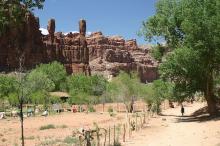Rural Tribal Priority Window Now Open; Advice from MuralNet - Community Broadband Bits Podcast 393

On February 3rd, 2020, the FCC opened the 2.5 GHz Rural Tribal Priority Window, a six month period in which federally recognized Tribes or Alaska Native Villages have the opportunity to apply for licenses to unassigned spectrum over their Tribal lands. This week on the podcast, we have two guests from MuralNet — CEO Mariel Triggs and Edyael Casaperalta, Legal Advisor and Policy Strategist. MuralNet, a nonprofit that focuses on helping indigenous people build their own networks, has been working to spread the word about the Rural Tribal Priority Window.
Historically, national Internet access companies have fallen short in bringing their services to people living on tribal lands. A few Tribes have been able to develop their own community networks, but others have found roadblocks when competing with large ISPs for spectrum or for funding. As a result, Tribal communities are some of the least connected in the U.S. Mariel and Edyael discuss how fixed wireless, using the 2.5 Ghz band spectrum is well suited to help solve this persistent problem. They share some of the challenges they’ve faced and offer some tips with deployment and in working to develop policy.
We learn more about the criteria that tribes need to meet in order to apply and how, even if they don’t plan on building their own network, owning access to the spectrum is, nevertheless, empowering. Tribes may not wish to operate a community network, but owning the airwaves above their land gives them some control over how those airwaves are used.
To learn more about the claiming the airwaves over Tribal Land, check out MuralNet’s website here. They're always willing to answer questions and to help with the process.
Legal Disclaimer: MuralNet employees and contractors are not attorneys. Services offered and statements from MuralNet in this podcast are not legal advice or opinion.
For more information from the FCC, including application information, maps, and any additional requirements, visit their cache of information here.
The Tribal Priority Window closes on August 3rd, 2020, at which time other entities will be able to apply for the licenses.
This show is 47 minutes long and can be played on this page or via Apple Podcasts or the tool of your choice using this feed.
Transcript below.
We want your feedback and suggestions for the show-please e-mail us or leave a comment below.
Listen to other episodes here or view all episodes in our index. See other podcasts from the Institute for Local Self-Reliance here.
Thanks to Arne Huseby for the music. The song is Warm Duck Shuffle and is licensed under a Creative Commons Attribution (3.0) license.
Image of Cibecue, Fort Apache reservation settlement in Arizona by Phillip Capper from Wellington, New Zealand [CC BY]


